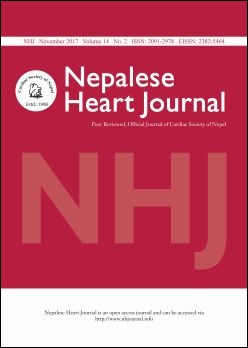Frequency of electro-cardiographic changes in patients of acute organophosphate poisoning at tertiary care hospital Larkana, Pakistan
DOI:
https://doi.org/10.3126/njh.v14i2.18495Keywords:
Acute organophosphate poisoning, ECG changes, QTC interval, ST elevation.Abstract
Background and Aims: The organophosphate (OP) poisoning is one of the important preventable public health problems in developing countries. It is estimated that OP pesticide self-poisoning kills around 200,000 people every year. The aim of the study was to determine the frequency of electrocardiographic (ECG) changes in acute OP poisoning at tertiary care hospital Larkana, Pakistan.
Methods: It was an observational retrospective study of the patients who were diagnosed with acute OP poisoning during the period of four years January 2012 to December 2015 at medical emergency department, Shaheed Mohtarma Benzir Bhutto Medical University Hospital Larkana, Pakistan. A sample of 223 patients between 16-45 years with definite history of OP ingestion, were included in study. Patients with the history of cardiac disease, diabetes mellitus, hypertension, chronic renal failure and electrolyte imbalance were excluded.
Results: Mean age was 29.61 ± 8.656 years with range of 16-45 years. Duration of OP ingestion ranged from 30 to 300 minutes with mean of 167.53 ± 45.26 minutes. Sixty five percent patients were in their 3rd and 4th decades of life. Males were 122 (54.71%) while 101 (45.29%) were females. ECG changes found in 145 (65.02%) with tachycardia and bradycardia was 85 (38.1%) and 60 (26.9%) respectively. The ST elevation was noted in 59 (26.5%), depression in 50 (22.4%), T wave changes observed in 51 (22.9%) patients. QTc interval was prolonged in 129 (57.85%).
Conclusion: ECG changes are frequent in OP patients. QTc interval followed by sinus arrhythmias were most common changes observed. ECG should be done in all the patients who present with OP poisoning.
Nepalese Heart Journal 2017; Vol 14(2), 5-8
Downloads
Downloads
Published
How to Cite
Issue
Section
License
This license enables reusers to distribute, remix, adapt, and build upon the material in any medium or format, so long as attribution is given to the creator. The license allows for commercial use.




